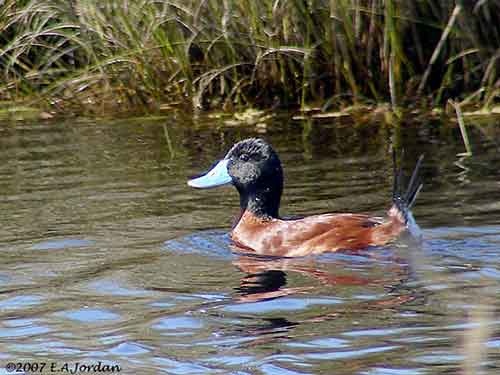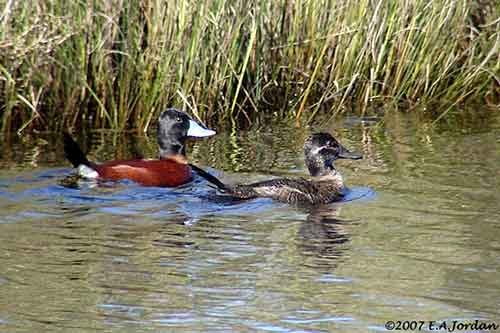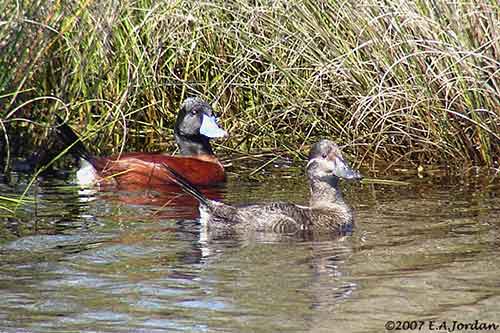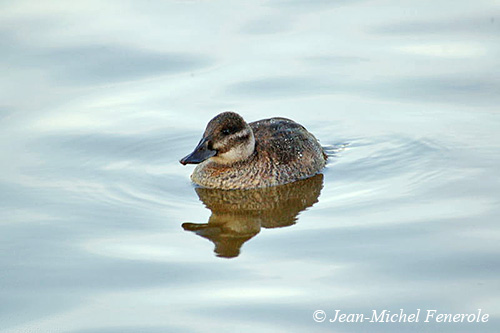
PROTECTION / THREATS / STATUS:
The Lake Duck is threatened by changes in the habitat, and the aquatic vegetation is often destroyed by fishermen, involving reduction of the population in these areas.
Protected reserves will be probably established to assure continuity of the species.
The Lake Duck is generally described as local and uncommon throughout the range.
The population is roughly estimated at 25,000/100,000 individuals. It is suspected to be stable and the Lake Duck is currently evaluated as Least Concern.
Fr: Erismature ornée
Ang: Lake Duck - Argentine Lake Duck - Argentine Blue-bill
All: Bindenruderente
Esp: Malvasía Argentina
Ita: Gobbo lacustre
Nd: Argentijnse Stekelstaart
Sd: argentinsk kopparand
Photographers:
Jean Michel Fenerole
Photos d’Oiseaux du monde
Eduardo Andrés Jordan
MIS AVES – AVES DE ARGENTINA
Text by Nicole Bouglouan
Sources:
HANDBOOK OF THE BIRDS OF THE WORLD vol 1 by Josep del Hoyo-Andrew Elliot-Jordi Sargatal - Lynx Edicions - ISBN: 8487334105
GUIDE DES CANARDS, DES OIES ET DES CYGNES – de Steve Madge - Delachaux et Niestlé - ISBN: 2603013769
Aves de los humedales chilenos: Guía de campo - De Pedro Pablo Rosso, Jaime Álvarez – Editeur: Ediciones UC, 2022 – ISBN: 9561430371, 9789561430372 – 240 pages
Wildfowl Photography - Ducks, Geese and Swans from around the world
Wikipedia, the free encyclopaedia
Lake Duck
Oxyura vittata
Anseriformes Order – Anatidae Family
INTRODUCTION:
The Lake Duck is found in Chile and Argentina, S to Tierra del Fuego. It moves N to SE Brazil and Paraguay in winter.
It lives in wetlands and lakes with a large amount of vegetation where it feeds on seeds, plant remains and aquatic insects and invertebrates.
This species breeds in solitary pairs or loose groups. The nest is a platform built over water in dense vegetation. The female performs alone the nesting duties.
The Lake Duck is described as local and uncommon throughout the range, but the species is not globally threatened at the moment.
DESCRIPTION OF THE BIRD:
Biometrics:
Length: 36-46 cm
Weight: M: 600-850 g – F: 540-700 g
The Lake Duck adult male has rich, dark chestnut body plumage. On the underparts the reddish breast becomes greyish to silvery white on centre of both breast and belly. The undertail coverts are chestnut with white tips.
Wings and tail are dark brown, but the underwing is greyish-white with white axillaries. The tail has stiff rectrices raised at 45° when the duck is at rest.
Head and neck are black. The large, blue bill has pinkish-yellow cutting edges. The eyes are dark brown. Legs and webbed feet are dark greyish-blue.
The male in eclipse resembles female but with greyer head, whiter throat and more rufous body.
The Lake Duck male is known to have a very long penis, sometimes as long as the bird itself, but more commonly about half the bird’s length. The spiny penis with bristled tips is suspected to remove the sperm from previous copulations.
This physical feature may have evolved in response to competitive pressure between these highly promiscuous birds.

The female has brown body with reddish-buff back and barred brown-and-white flanks.
The head is dark brown on crown and nape, with golden tones. Cheeks, chin and throat are whitish. We can see a narrow, horizontal, dark brown stripe, extending from the base of lower mandible through the cheek and to the nape. Wings and tail are like in male.
The bill is slate-grey. Legs and feet are bluish-grey.
The female in eclipse lacks the warm brown tones in her plumage.
The juvenile resembles female, but with paler upperparts and browner underparts. The feathers show buff fringes.
RANGE:
The Lake Duck occurs in S Argentina and Chile, S to Tierra del Fuego. It is rarely seen in Uruguay. The species has been introduced to the Falkland Islands.
It spends the winter N to SE Brazil and Paraguay.
HABITAT:
The Lake Duck frequents marshes, small pools and shallow freshwater lakes with dense vegetation on the shores. The species is visible from sea level up to 800 metres of elevation.
During winter, it usually frequents larger lakes and lagoons.
CALLS AND SONGS: SOUNDS BY XENO-CANTO
The Lake Duck male becomes vocal during the courtship displays. It produces soft popping sounds “pup-pup-pup-prup” and mechanical noises while displaying.
If the female resists the unwanted pursuit by the male, she gives high-pitched squeaks. These sounds are also used by the females during aggressive interactions. When disturbed during the incubation, she hisses at intruders and predators.

BEHAVIOUR IN THE WILD:
The Lake Duck is omnivorous and feeds mainly on seeds, aquatic insects, snails, worms and small crustaceans.
However, while migrating, it also consumes algae.
The Lake Duck dips its long neck into the water to catch a prey or to reach food items just under the water surface.
At the beginning of the breeding season, the male performs some courtship displays accompanied by sounds. The male creates graceful movements with both wings and legs, involving a great synchronisation with the female.
Once the male is accepted, the pair searches for a good place to build the nest, usually near bodies of water, often lake or river.
The female performs alone the nesting duties, although the male defends her during the laying.
The males may fight regularly, but usually for a short time. During the incubation, the female defends the nest aggressively against intruders.
The Lake Duck of the southernmost parts of the range moves as far N as S Brazil, Paraguay and SE Bolivia, to spend the winter in more temperate regions.
The other populations are largely sedentary and only perform short movements. On the other hand, severe droughts involve wide-ranging dispersal.
The Lake Duck rarely flies, or only when facing a real danger. If threatened, the birds fly away at high speed. Actually, the species is able to fly at high speed, allowing it to leave quickly the area.

REPRODUCTION OF THIS SPECIES:
In Argentina, the breeding season takes place from October to January. In Chile, two clutches are usually reported.
The Lake Duck is more strongly monogamous than other species of genus Oxyura. But extra-pair copulations are reported. The species may nest solitary or in loose groups.
The nest is built over the water, a flat platform among the dense vegetation.
The female lays 3-5 white eggs (more eggs is the result of parasitism). She incubates alone during 23-24 days. At hatching, the chicks have blackish-brown down with a white band below the eye. Throat and underparts are whitish. The bare parts are black. They fledge between 56 and 63 days after hatching. The female alone tends them, but she abandons them some weeks later.
